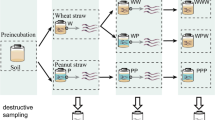Summary.
Nickel hyperaccumulator plants contain unusually elevated levels of Ni (>1,000 mg Ni kg−1). The high Ni concentration of hyperaccumulator tissues may affect ecosystem processes such as decomposition, but this has yet to be studied under field conditions. We used Senecio coronatus Thunb. (Harv.) from two pairs of serpentine sites: one member of each pair contained a hyperaccumulator population and the other a non-hyperaccumulator population. Our main goal was to determine if leaf Ni status (hyperaccumulator or non-hyperaccumulator) affected leaf decomposition rate on serpentine sites. We also used a non-serpentine site on which leaves from all four S. coronatus populations were placed to compare decomposition at a single location. Dried leaf fragments were put into fine-mesh (0.1 mm) nylon decomposition bags and placed on field sites in mid-summer (early February) 2000. Sets of bags were recovered after 1, 3.5, and 8 months, their contents dried and weighed, and the Ni concentration and total Ni content of high-Ni leaves was measured. For the serpentine sites, there was no significant effect of leaf Ni status or site type on decomposition rates at 1 and 3.5 months. By 8 months, leaf Ni status and site type significantly influenced decomposition on one pair of sites: hyperaccumulator leaves decomposed more slowly than non-hyperaccumulator leaves, and leaves of both types decomposed more slowly on the non-hyperaccumulator site. At the non-serpentine site, the highest-Ni leaves (15,000 mg Ni kg−1) decomposed more slowly than all others, but leaves containing 9,200 mg Ni kg−1 did not decompose more slowly than non-hyperaccumulator leaves. Nickel in decomposing hyperaccumulator leaves was released rapidly: after 1 month 57–68% of biomass was lost and only 9–28% of original Ni content remained. We conclude that very high (>10,000 mg Ni kg−1) leaf Ni concentrations may slow decomposition and that Ni is released at high rates that may impact co-occurring litter- and soil-dwelling organisms.
Similar content being viewed by others
Author information
Authors and Affiliations
Corresponding author
Rights and permissions
About this article
Cite this article
Boyd, R.S., Davis, M.A. & Balkwill, K. Does hyperaccumulated nickel affect leaf decomposition? A field test using Senecio coronatus (Asteraceae) in South Africa. Chemoecology 18, 1–9 (2008). https://doi.org/10.1007/s00049-007-0387-7
Received:
Accepted:
Published:
Issue Date:
DOI: https://doi.org/10.1007/s00049-007-0387-7




